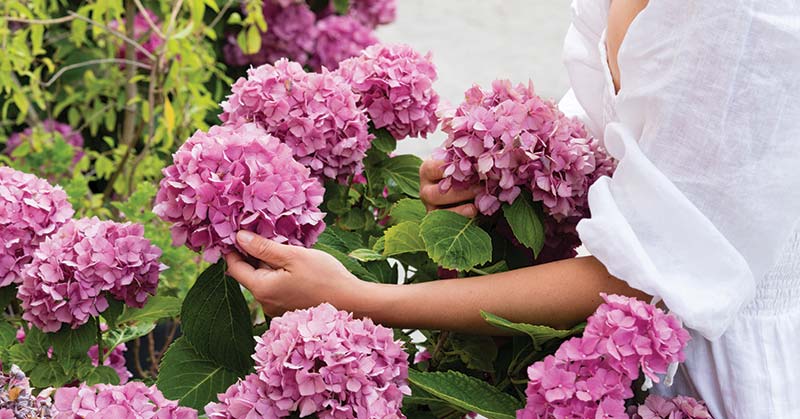Hydrangeas, with their grandiose blooms and varied hues, are a favorite among gardeners and flower enthusiasts alike. These lush plants can transform any garden into a picturesque scene right out of a storybook. If you’re looking to start your hydrangea journey, you’ve come to the right place.
In this post, we’ll explore everything you need to know about starting hydrangeas, from choosing the right variety to ensuring they thrive.
Step 1: Selecting the Right Variety
First things first, you need to select the right type of hydrangea for your garden. Hydrangeas come in several varieties, each with its own unique needs and characteristics. Some popular types include:
- Bigleaf hydrangeas (Hydrangea macrophylla): Known for their large, vibrant blooms, these are great for warmer climates.
- Panicle hydrangeas (Hydrangea paniculata): These are more cold-hardy and can withstand harsher climates.
- Smooth hydrangeas (Hydrangea arborescens): Ideal for those who prefer white or cream-colored flowers.
- Oakleaf hydrangeas (Hydrangea quercifolia): Recognizable by their oak leaf-shaped foliage, these are great for adding texture to your garden.
Step 2: Finding the Perfect Spot
Location is key for hydrangeas. They generally prefer morning sun and afternoon shade, especially in hotter climates. In cooler areas, they can handle more sun. The soil should be well-draining but moist, rich in organic matter.
Ensure the spot you choose can accommodate the full grown size of the plant – hydrangeas can grow quite large!
Step 3: Planting Your Hydrangeas
The best time to plant hydrangeas is in early spring or fall. Here’s a step-by-step guide to planting them:
- Prepare the Soil: Amend your soil with compost to ensure it’s rich in nutrients.
- Dig a Hole: The hole should be as deep as the root ball but twice as wide.
- Place the Plant: Set the hydrangea in the hole, making sure the top of the root ball is level with the ground.
- Backfill the Hole: Fill the hole with soil and gently pat it down.
- Water Generously: After planting, water the hydrangea thoroughly.
Step 4: Watering and Fertilizing
Hydrangeas love water. In the growing season, they may need watering every day, especially if the weather is dry. However, avoid waterlogging as this can lead to root rot. For fertilizing, use a balanced, slow-release fertilizer in spring.
Over-fertilizing can harm your plants, so follow the instructions on the fertilizer package carefully.
Step 5: Pruning and Care
Pruning hydrangeas can be a bit tricky, as it depends on the type. Some hydrangeas bloom on old wood, while others on new wood. Generally, prune in late winter or early spring. Remove dead wood and thin out crowded areas.
For specific pruning instructions, research the needs of your particular hydrangea variety.
Step 6: Dealing with Pests and Diseases
While hydrangeas are relatively hardy, they can still fall prey to pests like aphids and diseases like powdery mildew. Regularly inspect your plants and treat any issues promptly with appropriate organic or chemical treatments.
Step 7: Enjoying the Blooms
Once established, hydrangeas will reward you with stunning blooms year after year. The colors can vary based on the soil pH – acidic soils produce blue flowers, while alkaline soils lead to pink ones.
Conclusion
Starting hydrangeas might seem daunting, but with the right knowledge and care, you can easily grow these magnificent plants in your garden.
Remember to choose the right variety, provide the appropriate conditions, and give them the care they need. Soon, you’ll be basking in the beauty of your hydrangea blooms!
FAQs on How do you Start Hydrangeas
Q: What is the best time of year to plant hydrangeas?
A: The ideal time to plant hydrangeas is in early spring or fall when the weather is cooler and the plants are less likely to experience stress.
Q: How much sunlight do hydrangeas need?
A: Hydrangeas generally prefer morning sun and afternoon shade. In cooler climates, they can tolerate more sun, but in hotter areas, they benefit from being protected from intense afternoon sun.
Q: What type of soil is best for hydrangeas?
A: Hydrangeas thrive in moist, well-draining soil that is rich in organic matter. The soil pH can affect the flower color, with acidic soils producing blue flowers and alkaline soils leading to pink flowers.
Q: How often should I water my hydrangeas?
A: Hydrangeas need consistent moisture, especially during their growing season. Water them thoroughly a few times a week, more frequently in dry conditions, but avoid overwatering as this can lead to root rot.
Q: Do hydrangeas need fertilizer?
A: Yes, hydrangeas benefit from fertilization. Use a balanced, slow-release fertilizer in the spring. Avoid over-fertilizing, as this can harm the plant.
Q: How do I prune hydrangeas?
A: Pruning methods depend on the type of hydrangea. Some bloom on old wood, while others on new wood. Generally, prune in late winter or early spring, removing dead or weak stems to encourage healthy growth and blooms.
Q: Can I change the color of my hydrangea flowers?
A: Yes, the flower color can change based on the soil pH. To encourage blue flowers, increase the soil’s acidity; for pink flowers, make the soil more alkaline. This is done by adding specific soil amendments.
Q: How do I protect my hydrangeas in winter?
A: In colder climates, protect your hydrangeas by mulching around the base and covering them with burlap or frost blankets during harsh winter conditions.
Q: Can hydrangeas be grown in containers?
A: Yes, hydrangeas can be grown in containers. Ensure the container is large enough for the root system and has good drainage. Container-grown hydrangeas may require more frequent watering.
Q: What are common pests and diseases that affect hydrangeas?
A: Hydrangeas can be affected by pests like aphids and diseases such as powdery mildew. Regularly inspect your plants and treat problems early with appropriate organic or chemical treatments.




